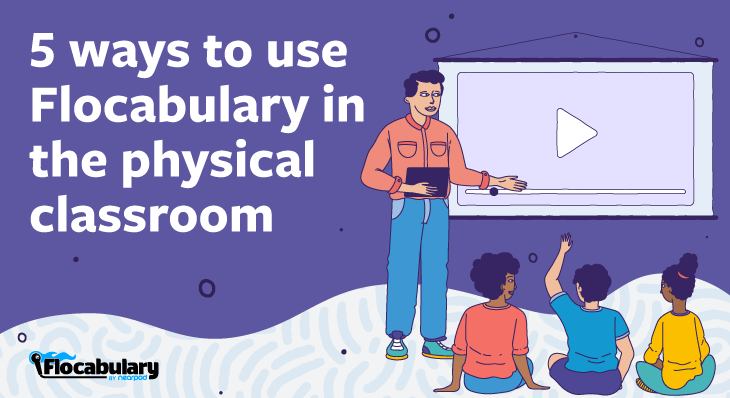
5 ways to use Flocabulary in the physical classroom
Over the last year teachers have used more online edtech products than ever before. As you shift back to the physical classroom you might be considering which products will be the most impactful to use, or how you’ll take your new favorite platforms and integrate them into an in-person classroom setting.
We know that vocabulary is the biggest predictor of reading comprehension, and using Flocabulary is a great tool to focus on vocabulary acquisition while also bringing culturally responsive teaching practices into the classroom. Here are a few ways to turbocharge your Flocabulary usage as you shift back to the physical classroom.
Host a poetry slam
Flocabulary’s Lyric Lab activity helps students write their own raps about topics or lessons they’ve worked on. However, students use this same feature to write poetry too. With Lyric Lab’s built-in rhyme generator it’s the perfect tool to use for hosting a classroom or school-wide poetry slam.
A poetry slam is just a competitive performance of poetry. Not only will students be writing poetry about a topic you’ve found in our K-12 standards-aligned lessons, but they’ll perform it too, building confidence and communication skills along the way.
To host a poetry slam you need to jump right into finding dates and times, organize video and audio (if needed), and dive into what lessons students can use to learn about a topic or concept and get writing.
While students may want to do their poem on one of the many figures in our biography section, you can also try Flocabulary lessons on different topics to support students creating their best poems. Here are a few of our favorite lessons to support poetry writing:
- What is Poetry?
- Types of Poetry
- Rhyme & Rhythm
- Hyperbole
- Alliteration and Assonance
- Irony
- Onomatopoeia
- Similes & Metaphors
- Figurative language
Host a rap battle
Lyric Lab is built for students to write their own raps, so instead of having students compete to do a poetry slam, jump right into a rap battle. Students will be thrilled to compete and take advantage of all of Lyric Lab’s features, including the built-in rhyme generator and selection of beats to choose from.
Rap battles are also a competitive performance. As a teacher your role is to guide students to do this activity, while they get up and build their confidence through their own performance skills and creativity.
Students can select a favorite lesson of their choice for a rap battle, or you can select one for the whole class to use. Structure the rap battle in whatever format works best for you. The Hip-hop Fundamentals lesson can help students approach the rap battle knowing the history of hip-hop.
Show the Flocabulary video in discussion mode
Flocabulary’s lesson activities are rooted in vocabulary and hip-hop. Each lesson has a standards-aligned video great for introducing the topic or concept’s vocabulary to students.
Videos are about 3 minutes long and are a great way to start a lesson. Show the video once for students to get to know the terms.
Show it a second time and put it in discussion mode. Discussion mode stops the video at important points and asks questions to keep students engaged. Discussion mode is a great way for students to reflect on new vocabulary terms and gain confidence to apply the terms in additional instructional activities in each Flocabulary lesson.
Use lesson activities for independent student work
Students benefit from additional opportunities to practice using vocabulary in context. After showing the video to your whole class, and working through modeling further in lessons, teachers can assign additional activities within a lesson to build mastery of vocabulary. Each Flocabulary activity deepens student skills by providing vocabulary practice in a variety of complexities.
These activities can be done as independent work, in stations, or in centers while teachers connect with students one-on-one or in small groups to reteach, provide differentiation, or enrich students. Independent work time is a great time for teachers to meet students where they are at.
Create a recommended playlist of videos students can listen to while working
Students love listening to music while they work. While students aren’t always allowed to stream their own music in class, it’s good to provide them with options they’ll love. Flocabulary can be a great tool for music in class. Provide students with a playlist of videos they’ve already studied in class. Revisiting them regularly is a great way to do spiral review.
While students are doing independent work, allow them to listen to their Flocabulary playlist while teachers connect with students who need additional support. Students get to listen to music, but are also reviewing important Tier 2 and Tier 3 vocabulary terms at the same time to prepare them for standardized testing, future lessons, and life beyond the classroom.
Get started with your first Flocabulary lesson when you return to the classroom by searching Flocabulary for a K-12 standards-aligned lesson to supplement what you’re already teaching.
